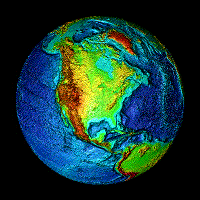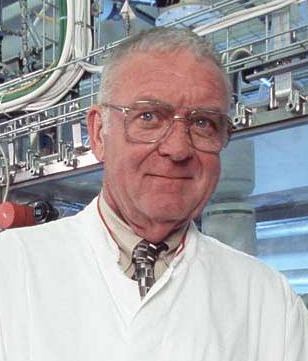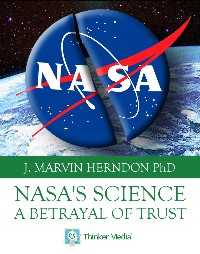

Science Suppression and Misrepresentation
 
Science Suppression and Misrepresentation |
 Earth's
inner core was discovered by Inge Lehmann in 1936 [1]. By 1940 Francis Birch and
others, believing that out planet resembles an ordinary chondrite meteorite,
pronounced its composition as iron metal in the process of crystallizing from
the melt [2]. Four decades later, J. Marvin Herndon, pictured at left, published
a different idea, namely, that the inner core is fully-crystallized nickel
silicide (click here)
[3] and the interior of the Earth resembles instead an enstatite chondrite
meteorite (click here)
[4]. In science when an important new concept is published, there should be
debate and discussion; unless and until the idea is refuted, the publication
should be cited. But instead of engendering debate and discussion, these
advances [1, 2], and those that followed [5-16], have been systematically
ignored by government-funded researchers as if they never existed.
Earth's
inner core was discovered by Inge Lehmann in 1936 [1]. By 1940 Francis Birch and
others, believing that out planet resembles an ordinary chondrite meteorite,
pronounced its composition as iron metal in the process of crystallizing from
the melt [2]. Four decades later, J. Marvin Herndon, pictured at left, published
a different idea, namely, that the inner core is fully-crystallized nickel
silicide (click here)
[3] and the interior of the Earth resembles instead an enstatite chondrite
meteorite (click here)
[4]. In science when an important new concept is published, there should be
debate and discussion; unless and until the idea is refuted, the publication
should be cited. But instead of engendering debate and discussion, these
advances [1, 2], and those that followed [5-16], have been systematically
ignored by government-funded researchers as if they never existed.
Humans tend to be optimistic and forward-looking, but rarely look back critically at the actions and discoveries that have set them on their present paths. Scientific flaws, made in the past and not corrected, can distort scientific thought in the present. The same is true for science-administration actions. In 1951 the U. S. National Science Foundation (NSF), established to administrate post-WWII civilian science funding, invented the methodology that became the standard for other subsequent agencies, such as NASA. The methodology invented, however, is seriously flawed and has for decades diminished and corrupted American science, as disclosed by J. Marvin Herndon in the following:
WebPage: Decline of American Science: The Cause and Cure (click here)
How serious and how institutionalized is the corruption?
Important Article: Corruption of Science in America (click here for pdf)
 On July 20, 1969, NASA forever changed human history when astronauts
first stepped on the Moon. But what happened after that fateful
footstep? How did NASA change from a pioneering organization into a
members-only bureaucracy that stifles scientific thought? J. Marvin
Herndon tackles this question in his book, NASA�s Science: A
Betrayal of Trust. Herndon cites examples of NASA neglect and
censorship over the past 50 years and explains how the organization
willfully chooses to ignore ethical scientific standards in favor of supporting
their �accepted� truth. With special focus on NASA�s reliance on
fallible models, the fallibility of models, history of data suppression
and failure to cite divergent viewpoints, Herndon presents a very
different view of the world�s premier space agency.
On July 20, 1969, NASA forever changed human history when astronauts
first stepped on the Moon. But what happened after that fateful
footstep? How did NASA change from a pioneering organization into a
members-only bureaucracy that stifles scientific thought? J. Marvin
Herndon tackles this question in his book, NASA�s Science: A
Betrayal of Trust. Herndon cites examples of NASA neglect and
censorship over the past 50 years and explains how the organization
willfully chooses to ignore ethical scientific standards in favor of supporting
their �accepted� truth. With special focus on NASA�s reliance on
fallible models, the fallibility of models, history of data suppression
and failure to cite divergent viewpoints, Herndon presents a very
different view of the world�s premier space agency.
New eBook: NASA's Science: A Betrayal of Trust (picture at right) No Longer Available from Thinker Media, Inc. Publisher ceased publication of eBooks.
Return to Home Page (click here)
| References | |
| 1. |
Lehmann, I., P'. Publ. Int. Geod. Geophys. Union, Assoc. Seismol., Ser. A, Trav. Sci., 1936, 14, 87-115. |
| 2. | Birch, F., The transformation of iron at high pressures, and the problem of the Earth's magnetism. American Journal of Science, 1940, 238, 192-211. |
| 3. | Herndon, J. M., The nickel silicide inner core of the Earth. Proceedings of the Royal Society of London, 1979, A368, 495-500. (click here for pdf) |
| 4. | Herndon, J. M., The chemical composition of the interior shells of the Earth. Proceedings of the Royal Society of London, 1980, A372, 149-154. (click here for pdf) |
| 5. | Herndon, J. M., The object at the centre of the Earth. Naturwissenschaften, 1982, 69, 34-37. |
| 6. | Herndon, J. M., Nuclear fission reactors as energy sources for the giant outer planets. Naturwissenschaften, 1992, 79, 7-14. |
| 7. | Herndon, J. M., Feasibility of a nuclear fission reactor at the center of the Earth as the energy source for the geomagnetic field. Journal of Geomagnetism and Geoelectricity, 1993, 45, 423-437. (click here for pdf) |
| 8. | Herndon, J. M., Planetary and protostellar nuclear fission: Implications for planetary change, stellar ignition and dark matter. Proceedings of the Royal Society of London, 1994, A455, 453-461. (click here for pdf) |
| 9. | Herndon, J. M., Sub-structure of the inner core of the Earth. Proceedings of the National Academy of Sciences USA, 1996, 93, 646-648. (click here for pdf) |
| 10. | Hollenbach, D. F. and Herndon, J. M., Deep-Earth reactor: Nuclear fission, helium, and the geomagnetic field. Proceedings of the National Academy of Sciences USA, 2001, 98, 11085-11090. (click here for pdf) |
| 11. |
Herndon, J. M., Nuclear georeactor origin of oceanic basalt 3He/4He, evidence, and implications. Proceedings of the National Academy of Sciences USA, 2003, 100, 3047-3050. (click here for pdf) |
| 12. | Herndon, J. M., Whole-Earth decompression dynamics. Current Science, 2005. 89(10), 1937-1941. (click here for pdf) |
| 13. | Herndon, J. M., Nuclear georeactor generation of the Earth's geomagnetic field. Current Science, 2007, 93, 1485-1487. (click here for pdf) |
| 14. | Herndon, J. M., Nature of planetary matter and magnetic field generation in the Solar System. Current Science, 2009, 96, 1033-1039. (click here for pdf) |
| 15. | Herndon, J. M., Geodynamic basis of heat transport in the Earth. Current Science, 2011. 101, 1440-1450. (click here for pdf) |
| 16. | Herndon, J. M., Origin of mountains and primary initiation of submarine canyons: the consequences of Earth's early formation as a Jupiter-like gas giant. (click here for pdf) Current Science, 2012, 102, 1370-1372. |